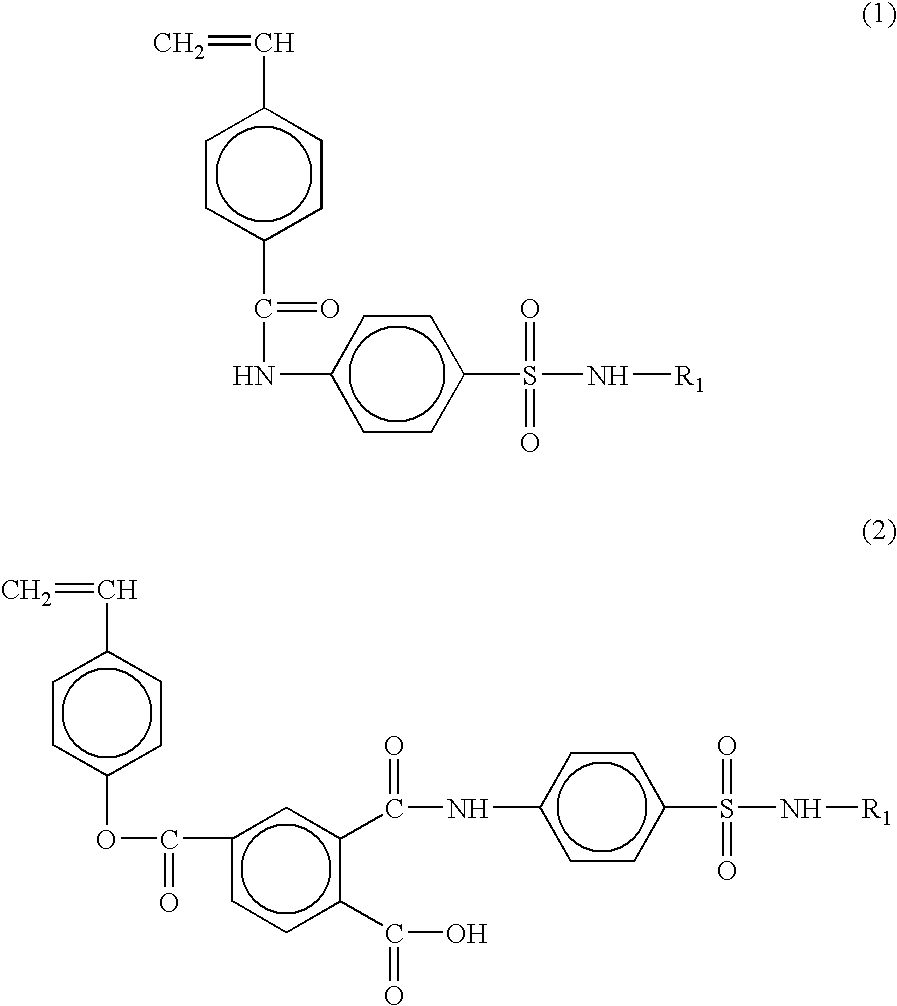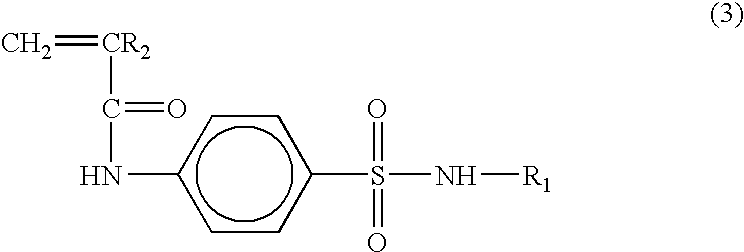Dual stimuli-responsive hydrogels and their synthetic methods
a hydrogel and stimuli technology, applied in the direction of solution delivery, aerosol delivery, medical preparations, etc., can solve the problem of difficulty in controlling the molecular weight of the hydrogel formed
- Summary
- Abstract
- Description
- Claims
- Application Information
AI Technical Summary
Benefits of technology
Problems solved by technology
Method used
Image
Examples
example 1
The styrene-based monomer of 4-vinylbenzoyl-4-amino-N-(4,6-dimethyl-2-pyrimidyl) benzenesulfonamide exhibiting a pH-responsive property was synthesized by reacting sulfamethazine having the pK.sub.a value of 7.4 with 4-vinylbenzoic acid.
5 g of 4-vinylbenzoic acid and 0.34 mole of triethylamine were delivered into a 500 mL, 3 neck round bottom flask equipped with a reflux system under inert nitrogen gas, followed by adding 150 mL of tetrahydrofuran. Subsequently, 0.34 mole of ethylchloroformate was injected thereto at -20.degree. C. and the reactor was stirred for 1 h.
To the resulting solution in the reactor, 0.34 mole of sulfamethazine dissolved in 200 mL of tetrahydrofuran, was delivered by using a syringe, followed by reacting for another 1 h. After the reaction was completed, the resulting product was washed with aqueous HCl (1 N) and aqueous Na.sub.2 CO.sub.3 solution, at least three times. The resulting white solid was purified by re-crystallization in a mixture of acetone-hexa...
example 2
The styrene-based monomer of 4-vinylbenzoyl-3-(p-aminobenzensulfamido)-6-methoxypyridazine was synthesized by reacting 0.34 mole of sulfamethoxypyridazine having the pK.sub.a value of 6.7 under the same conditions described in Example 1, followed by purification of the resulting product. The yield of the resulting monomer was 42%.
example 3
The styrene-based monomer of 4-vinylbenzoyl-2,4-dimethoxy-6-sulfanylamido-1,3-diazine was synthesized by reacting 0.34 mole of sulfamethoxine with 4-vinylbenzoic acid under the same conditions as Example 1. The yield of the resulting monomer was 62%.
PUM
| Property | Measurement | Unit |
|---|---|---|
| temperature | aaaaa | aaaaa |
| temperature | aaaaa | aaaaa |
| pKa | aaaaa | aaaaa |
Abstract
Description
Claims
Application Information
 Login to View More
Login to View More - R&D
- Intellectual Property
- Life Sciences
- Materials
- Tech Scout
- Unparalleled Data Quality
- Higher Quality Content
- 60% Fewer Hallucinations
Browse by: Latest US Patents, China's latest patents, Technical Efficacy Thesaurus, Application Domain, Technology Topic, Popular Technical Reports.
© 2025 PatSnap. All rights reserved.Legal|Privacy policy|Modern Slavery Act Transparency Statement|Sitemap|About US| Contact US: help@patsnap.com



